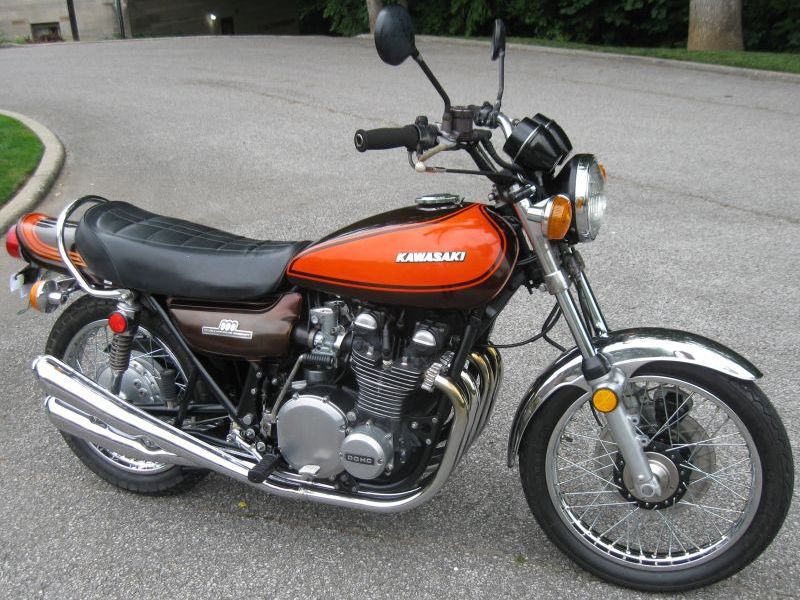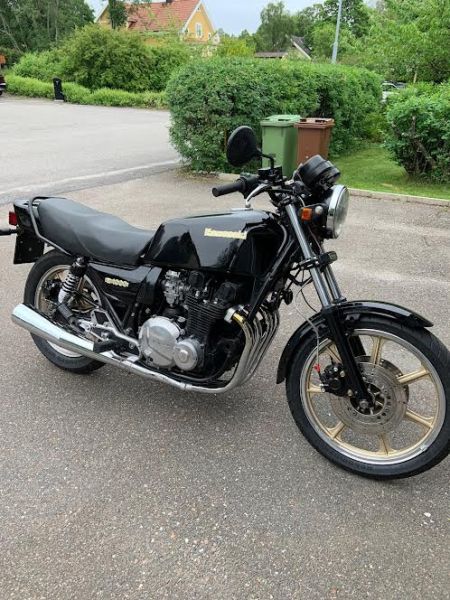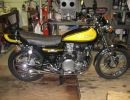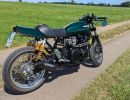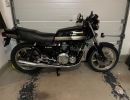Gentlemen, I have a sooty, carbon-fouled spark plug problem that I believe needs to be solved with adjustments to the carbs and would appreciate some of your insight:
-1975 Z1-B 900 bored out 0.020”, new valves and guides (200 miles on engine since rebuild)
-1976 VM26SS Mikuni carbs with pilot air screw (no pilot fuel screw)
-Kerker 4 to 1 pipes with baffle
-Air box with K&N filter
-Compression – low to mid 120’s (book says it should be 145 psi)
-Spark plugs taped to head with engine cranking – bright, crisp sparks
I checked out the thread titles in the Carburetor forum and investigated approximately 50% of the threads to see if they touched on my problem and got quite an education in the process! I am following the break-in procedure in the Kawasaki Shop Manual – first 500 miles no more than 1/3 throttle and limit engine rpm’s to 4000.
History: Very first ride got 1-1/2 miles down the road when the engine started misfiring – examined plugs and they were all equally covered with soot – lowered the fuel level to spec with clear tube method and was able to get 25 to 30 miles on the odometer before the plugs fouled and engine started misfiring. After each ride all 4 of the spark plugs had to be cleaned. The last ride was 15 miles and the last 5 of those miles the engine misfired as much as it fired. During the six or seven rides I replaced coils, points, condensers and went from the specified plug (NGK B8ES) to the recommended hotter plug for break-in (NGK B7ES). It turned out to be loose bullet connectors between the kill switch and coils that caused the bad misfire on the last ride. One other point – the electrical system connections were meticulously cleaned – there is very little voltage drop between battery and points.
Dad and I completed restoration of a 1959 Triumph TR-3 (English sports car) back in 2004, and since then I have done all of the maintenance and tuning. Working on that car is kind of like going out for a beer with your best friend – not real complicated. Getting the Kaw refurbished to the point of being ready to start the engine was like working on the TR-3. However, getting it ridable is starting to feel like the equipment manager for the high school football team thinking he has a chance of getting a date with the head cheer leader – ain’t gonna happen! I guess what I need from the forum is your thoughts on the following questions.
1) I am concerned about an overly rich mixture washing the oil off the cylinder walls and carbon building up on the exhaust valves causing them to leak. Are those valid concerns?
2) What should I expect during break-in in the first 500 miles? I know that 4000 rpm’s is lugging the engine – should I just expect to have to occasionally clean the plugs – every 25 to 30 miles seems excessive?
3) What I learned during my KZR research was that during my rides I was having some of the symptoms that require adjustments to the pilot system – specifically a) pulling away from a red light the engine would bog down and require playing with the throttle and clutch to get going, and b) shutting the throttle at cruising speed would result in cracking and popping sounds coming from the exhaust, and shutting the throttle quickly would cause the cracking and popping sounds to be louder and more frequent. The carbs have the stock jets (115 main, 17.5 pilot) and needle (5DL31).
4) Previously, it was my understanding that cracking and popping in the exhaust was unburned fuel exploding in the exhaust pipes – the mixture being too rich. From my KZR research it seems just the opposite is the case – the pilot system is too lean. Is this true? Why does a lean mixture cause cracking and popping?
5) Regarding the engine bogging down upon cracking the throttle to pull away at a red light – it was my assumption that the rich mixture was causing that, but my KZR research said that if the pilot jets are too small, they won’t provide enough fuel for the instant increase in air flow when the throttle is opened. So where is the excess fuel coming from that is fouling the plugs?
6) I do not think the excess fuel is coming from the starter system – starter system works per the book, and after the engine is started and the starter system shut off, the engine idles nicely. However, regarding idle – the air screws are initially set at 1-1/4 turns out, but there is very little change in idle speed or engine note while adjusting the air screws in and out. Would this condition also indicate the pilot jets are too small?
7) Based on my KZR research I have decided to change out the needle and needle jet. The TR-3 was running rich and changing its needles and needle jets completely cured the problem. The book says to use a block of wood and gently tap the needle jet out the bottom of the carb – can anyone expand on this? Would it be helpful to soak it with WD-40 and/or warm it up with a heat gun before tapping it out?

My bike is basically set up the way I bought it in 1980, and back then it ran nicely and had a strong pull from mid-range up to the redline. Unfortunately, we had someone rebuild the carbs back in 2006 (before the current engine work), and they changed out whatever jets and needles were in the carbs and installed the current stock jets and needles. One thing I didn’t find in my KZR research was discussion on the effect of the 4 to 1 Kerker pipes on the system compared to the stock pipes. Since the Kerker exhaust is the only non-stock item on my bike, I was hoping to find some information on jetting related to the 4 to 1 pipes. What is the usual change to jetting for these pipes?
9) It seemed to idle and run smoothly after mechanically setting throttle slides with a sewing needle – would it help my carbon fouling problem if the carbs were vacuum balanced before riding?
10) Regarding balancing the carbs with a manometer, I have an old Motion Pro carb stick that uses mercury. Does anyone know if the level of mercury in the reservoir should be at the 0 centimeter line? The people at Motion Pro couldn’t help me here. Does anyone know where I can get a small amount of mercury?
11) After the last ride I drained the tank and the float bowls because I knew it was going to be a couple of months before gas was flowing thru the carbs. After a month had passed, I had the carbs off and the small hole in the bottom of the starter pipes and possibly the pilot jets had gummed over. I am using 91 octane no-ethanol gas. Any thoughts – would it be better to add Sta-bil to the gas and leave it in the carbs?
12) And possibly related to Item 11) – I could not find 3/16” ID rubber tubing for the vent and overflow lines on the carbs so I used clear plastic tubing. After each ride clear, oily liquid (maybe a tablespoon or two) would drain out of the overflow lines onto the garage floor. It looked and felt like thin silicone grease. It did not smell like gasoline. Are the gas fumes degrading the plastic lines or is that something evaporating out of the gas in the float bowls? In my KZR research the discussion on using the “chop method” for checking spark plug color, the contributors stated you had to put more miles on the plugs before chopping to get an accurate color due to changes in today’s gas. I’m just wondering if my gumming problem in Item 11) and the weird drainage from the overflow lines are related to the gas I’m using. Any thoughts?
13) Ok, last question, and thanks for your patience for anyone who is still with me. I was intrigued by the guys in the forum that were using the AFR gauges to dial in their jet sizes. Is there some good info on this process to download? For instance, how do set up the gauge to use? Is this a permanent fixture on your bike, etc.?
Any help here would be greatly appreciated!
Brad
 Feb '24 BOTM KZ750 by RustyB1
Feb '24 BOTM KZ750 by RustyB1 Feb '24 BOTM KZ750 by RustyB1
Feb '24 BOTM KZ750 by RustyB1

